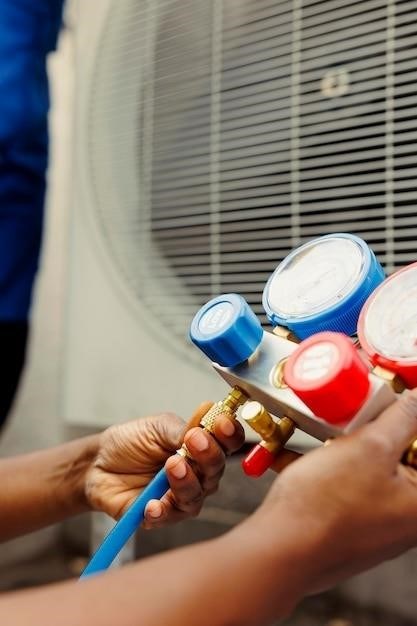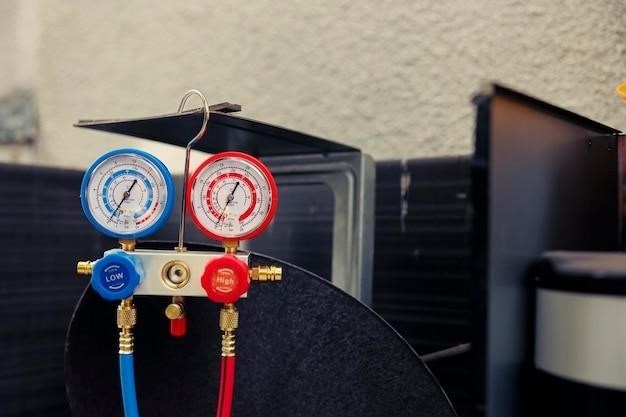carrier comfort pro apu ac refill instructions


Carrier Comfort Pro APU AC Refill⁚ A Comprehensive Guide
This guide provides a step-by-step process for refilling the air conditioning system in your Carrier Comfort Pro APU. It covers identifying refrigerant leaks, gathering necessary tools, safety precautions, and the refill procedure itself. Consult the service manual for detailed specifications and diagrams.
Understanding the Carrier Comfort Pro APU
The Carrier Comfort Pro APU is a vital component for maintaining comfortable temperatures within your truck’s cab. It’s a compact, efficient power source providing heating, cooling, and electrical power, minimizing reliance on the main engine. The system incorporates several automated features like Comfort Monitor, Timer, and Temp Start for optimized climate control. Understanding its operation is crucial for effective AC maintenance. The ComfortPro utilizes a refrigeration system, typically employing R-134a refrigerant, to achieve cooling. This system comprises a compressor, condenser, evaporator, and expansion valve, working together to transfer heat from inside the cab to the outside environment. Regular maintenance, including refrigerant level checks and refills, is essential to prolong its lifespan and ensure efficient performance. Ignoring these aspects can lead to premature component failure and reduced cooling capacity.
Identifying AC Issues and Error Codes
Before attempting an AC refill, accurately diagnosing the problem is paramount. Start by observing the APU’s control panel for any displayed error codes. These codes, specific to the Carrier Comfort Pro model, provide valuable clues about potential malfunctions. Refer to your APU’s service manual for a complete list of error codes and their corresponding meanings. Common issues include insufficient refrigerant, compressor failure, condenser problems, or leaks within the system’s lines. Check for unusual noises emanating from the AC unit, such as hissing or rattling, which could indicate leaks or mechanical problems. Inspect the AC vents for inadequate airflow or warm air, signifying insufficient cooling. If the AC compressor isn’t engaging, a faulty compressor or electrical problem might be at fault. A thorough examination of these aspects helps determine if a simple refrigerant top-up is sufficient or if professional servicing is required to address underlying mechanical issues.
Locating Service Manuals and Resources
Accessing comprehensive service manuals is crucial for successful Carrier Comfort Pro APU AC refills. These manuals provide detailed diagrams, specifications, and troubleshooting guidance specific to your APU model. Carrier Transicold’s official website is a primary resource, often offering downloadable manuals or links to authorized dealers who can provide them. Online forums and communities dedicated to trucking and APU maintenance can be invaluable sources of information, offering user experiences and troubleshooting tips. Websites specializing in heavy-duty truck parts and repair often have sections with manuals or links. Remember to always verify the authenticity and relevance of any online resource. Searching for your specific APU model number (e.g., PC6000) alongside “service manual” or “wiring diagram” usually yields relevant results. Utilizing a combination of online and offline resources ensures access to the most complete and accurate information for your particular Carrier Comfort Pro APU.
Gathering Necessary Tools and Materials
Before commencing the Carrier Comfort Pro APU AC refill, gather the essential tools and materials. This includes a set of AC gauges for precise refrigerant pressure readings, ensuring accurate charging. A vacuum pump is vital to evacuate the system of air and moisture before refilling, preventing damage to the compressor. Refrigerant, specifically R-134a, must be sourced from a reputable supplier, ensuring purity and proper handling; Appropriate fittings and hoses are necessary for connecting the gauges and refrigerant can to the APU’s service ports. Safety glasses and gloves are crucial for personal protection against refrigerant exposure and potential leaks. Wrenches or sockets might be needed to access service ports or other components. A reliable power source is essential to run the vacuum pump and potentially other tools. Consult the service manual for exact refrigerant type and quantity. Having all tools and materials readily available streamlines the refill process and minimizes downtime.
Safety Precautions Before Starting the Refill
Prior to initiating the Carrier Comfort Pro APU AC refrigerant refill, prioritize safety. Ensure the APU is completely powered down and disconnected from any power source to prevent accidental operation during the process. Always wear appropriate safety glasses and gloves to protect against refrigerant exposure and potential injuries. Work in a well-ventilated area to avoid inhaling refrigerant fumes, which can cause dizziness or other health problems. Handle the refrigerant can with care, avoiding any damage to the container that could lead to leaks. Never attempt to refill the system without a proper understanding of the process; consult the service manual for detailed instructions and diagrams. If unsure about any step, consult a qualified technician to avoid potential damage to the system or personal harm. Remember, refrigerant is under pressure and can cause serious injury if mishandled. Use proper tools and techniques to prevent leaks or accidental discharge. Always dispose of used refrigerant responsibly according to local regulations. Prioritizing safety ensures a smooth and hazard-free refill.
Step-by-Step AC Refill Procedure
Begin by locating the service ports on the Carrier Comfort Pro APU’s AC system. Consult your service manual for their exact location. Attach the refrigerant charging hoses to the low-pressure and high-pressure ports, ensuring secure connections to prevent leaks. Turn on the APU and allow the compressor to run. Connect the refrigerant can to the charging hose and carefully open the valve, allowing refrigerant to flow into the system. Monitor the gauges to track the pressure and temperature, ensuring they remain within the manufacturer’s specified ranges. Continue the refill process until the desired refrigerant level is reached. Once complete, close the refrigerant can valve and disconnect the charging hoses. Carefully inspect all connections for leaks using leak detection solution. Allow the system to stabilize and then test the AC functionality. If the system still does not function properly, refer to the troubleshooting section of the service manual or contact a qualified technician. Accurate monitoring and precise refrigerant addition are crucial for optimal performance.

Checking Refrigerant Levels and Pressure
Accurately checking refrigerant levels and pressures is vital for efficient Carrier Comfort Pro APU AC operation. Use appropriately calibrated gauges to measure both high-side and low-side pressures. These readings should correspond to the ambient temperature and the system’s operational state; consult the service manual for pressure-temperature charts specific to your APU model and refrigerant type (typically R-134a). Low-side pressure significantly below the chart’s indication suggests insufficient refrigerant, warranting a refill. Conversely, excessively high pressures might signal overcharging or a system blockage. Observe for unusual pressure fluctuations or inconsistent readings that might indicate a leak. Before taking measurements, ensure the APU’s AC system is running and has reached a stable operating temperature. Remember, improper refrigerant levels can severely impact the APU’s cooling capacity and potentially damage the compressor. Always refer to the manufacturer’s specifications and safety guidelines for accurate and safe refrigerant level checks.
Troubleshooting Common AC Problems
Troubleshooting your Carrier Comfort Pro APU’s air conditioning system begins with identifying the problem. A malfunctioning compressor is a common issue, often indicated by a lack of cooling despite the system being on. This might require professional attention and potential replacement. Inspect all electrical connections for loose wires or corrosion, as these can interrupt power to the compressor or other components. Check the AC breaker to ensure it hasn’t tripped; reset it if necessary. Examine the refrigerant lines for leaks using leak detection equipment, paying close attention to connections and seals. Low refrigerant levels, indicated by low pressure readings, require refilling, as detailed in this guide. Ensure the condenser fan is operating correctly; it plays a crucial role in heat dissipation. A clogged condenser can also hinder cooling performance. If the issue persists after these checks, consult the service manual’s troubleshooting section or contact a qualified Carrier technician. Remember, improper handling of refrigerants can be hazardous; always prioritize safety.
Maintaining Optimal APU Performance
Regular maintenance is crucial for prolonging the lifespan and efficiency of your Carrier Comfort Pro APU and its air conditioning system. Begin with visually inspecting all components for any signs of damage or wear, including loose connections, cracks, or leaks. Clean the condenser coils regularly to remove dust and debris that can impede heat transfer and reduce cooling efficiency. Check and tighten all belts, ensuring proper tension to prevent slippage and wear. Regularly inspect and change the air filter, as a clogged filter restricts airflow, impacting both heating and cooling performance. Schedule professional servicing at recommended intervals to address potential issues before they escalate into major problems. This preventative maintenance often includes a thorough inspection of the entire system, including refrigerant levels and pressure checks. Following the manufacturer’s recommended maintenance schedule will ensure your APU operates at peak performance, providing reliable heating and cooling for extended periods. Address any issues promptly to avoid costly repairs down the line.
Finding Certified Technicians and Dealers
Locating a certified technician or authorized Carrier dealer is essential for proper Carrier Comfort Pro APU service and repairs, especially for tasks such as AC refrigerant refills. Improper handling of refrigerants can be dangerous and void warranties. Begin by utilizing Carrier Transicold’s official website or app; these resources usually include a dealer locator tool to find nearby service centers. The locator typically allows you to filter results by location and services offered, ensuring you find a dealer specializing in APU maintenance and repair. When contacting potential service providers, confirm their certification and experience with Carrier Comfort Pro APUs. Inquire about their qualifications to handle refrigerants safely and their familiarity with the specific model of your APU. Request quotes upfront to compare prices and services. Read online reviews and testimonials to gauge customer satisfaction and identify reputable service providers. Choosing a qualified professional ensures the job is done correctly, safely, and efficiently, protecting your investment and maintaining optimal APU performance.
Sources for Replacement Parts and Refrigerant
Securing genuine Carrier parts and the correct refrigerant type is crucial for maintaining your APU’s warranty and ensuring optimal performance. Avoid using generic or aftermarket components, as these may not meet Carrier’s specifications and could damage your system. Carrier Transicold’s authorized dealers are your primary source for genuine parts, including compressors, condensers, evaporators, and refrigerant. Their inventory typically includes parts specific to your APU model. Online retailers specializing in heavy-duty truck parts may also carry Carrier components, but always verify authenticity and check customer reviews before ordering. For refrigerant, only use the type specified in your APU’s service manual. Improper refrigerant can severely damage the system. Purchase refrigerant from reputable suppliers who can provide certifications confirming its purity and proper handling. Never attempt to source refrigerant or parts from unknown or uncertified vendors. Using incorrect materials voids your warranty and can lead to costly repairs or system failure down the line. Always prioritize quality parts and refrigerant from authorized sources.
Additional Tips and FAQs
Regular maintenance is key to extending the lifespan of your Carrier Comfort Pro APU’s AC system. This includes inspecting hoses and connections for leaks, checking refrigerant levels periodically, and cleaning the condenser coils to ensure efficient heat dissipation. Remember to always consult your APU’s service manual for specific maintenance recommendations and intervals. A common question is about the frequency of refrigerant refills. This varies greatly depending on system usage and potential leaks. If your AC performance degrades significantly (e.g., weak airflow, poor cooling), a refrigerant leak is suspected. Professional inspection is recommended in this case. Another frequently asked question involves the use of specific tools. While some basic hand tools might be suitable for simple tasks, refrigerant handling requires specialized equipment like gauges and vacuum pumps. Improper handling can lead to injury and system damage. Lastly, understand that attempting major repairs or refrigerant recharging without proper training and certification is extremely dangerous and can void warranties. Always contact a qualified technician for extensive repairs or if you’re unsure about any aspect of the process.
Leave a Reply
You must be logged in to post a comment.